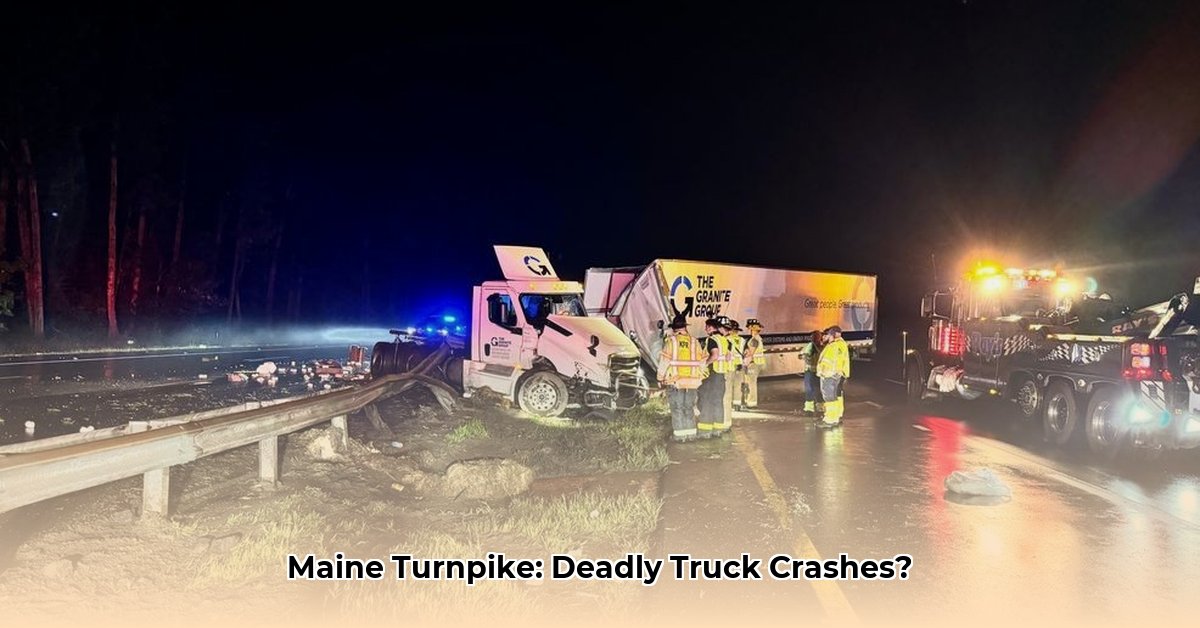
Two devastating tractor-trailer crashes on the Maine Turnpike within a week have resulted in fatalities and significant traffic disruptions, demanding immediate action and a comprehensive safety review. This incident highlights systemic vulnerabilities on Maine's busiest highway. For more information on speed limits, see this resource.
A Closer Examination of the Turnpike Tragedies
The recent accidents underscore the urgent need for improved safety measures. One crash resulted in fatalities, while the other caused significant traffic congestion for hours. These tragic events have raised serious concerns about the safety of the Maine Turnpike for all users.
Unraveling the Causes: Initial Findings and Ongoing Investigations
While investigations are ongoing, preliminary reports suggest a potential correlation between adverse weather conditions and at least one of the accidents. However, other factors, including driver fatigue, mechanical failures, and potentially road design, may also have contributed. A thorough investigation is crucial to determine the exact causes and identify any systemic weaknesses. This investigation must examine all aspects, from weather conditions and driver behavior to vehicle maintenance and road design.
Shared Responsibility: The Roles of Key Stakeholders
Efforts to improve safety require collaboration among multiple stakeholders. The Maine Department of Transportation (MaineDOT), the Maine Turnpike Authority (MTA), trucking companies, and law enforcement all have critical roles to play. MaineDOT must conduct thorough, transparent investigations, publish detailed reports, and implement immediate safety measures, such as improving signage and potentially lowering speed limits in high-risk areas. The MTA needs to increase patrols, particularly focusing on commercial vehicles and implementing stricter enforcement of speed limits. Trucking companies must prioritize driver safety through improved training, vehicle maintenance, and strict adherence to hours-of-service regulations. Law enforcement needs increased patrols targeting commercial vehicles, focusing on speeding and distracted driving.
Immediate Actions: Short-Term Mitigation Strategies
Several short-term actions can be implemented immediately to enhance safety:
- Enhanced Road Signage: Improve the visibility and clarity of warning signs, especially in areas prone to hazardous conditions.
- Temporary Speed Reductions: Implement temporary speed reductions in high-risk zones during adverse weather.
- Increased Patrols: Increase law enforcement patrols on the Turnpike, concentrating on times of heightened risk.
- Real-Time Traffic Information: Improve the accuracy and timeliness of traffic alerts to better inform drivers of real-time road conditions.
- Driver Fatigue Initiatives: Trucking companies should implement stricter policies on driver fatigue and mandatory rest breaks.
- Vehicle Maintenance Checks: Mandate more frequent and thorough inspections of commercial vehicles to ensure roadworthiness.
Long-Term Strategies: Building a Safer Future
Addressing the root causes of these accidents requires long-term strategies:
- Advanced Weather Monitoring: Implement a sophisticated weather monitoring system along the Turnpike for more accurate forecasts and proactive traffic management.
- Improved Road Design: Conduct a comprehensive review of the Turnpike’s design to identify areas requiring improvements for better traffic flow and safety.
- Advanced Driver-Assistance Systems (ADAS): Encourage or mandate the use of ADAS in commercial vehicles to reduce accident likelihood.
- Ongoing Driver Education: Implement continuous training programs for commercial drivers focusing on safe driving practices in adverse weather and proper ADAS usage.
Risk Assessment: Prioritizing Mitigation Efforts
A preliminary risk assessment highlights critical areas requiring immediate attention:
| Factor | Likelihood of Failure | Severity of Impact | Risk Rating | Mitigation Strategy |
|---|---|---|---|---|
| Adverse Weather Conditions | High | High | Very High | Enhanced weather forecasting, timely lane closures, advanced warning systems, improved road surfacing |
| Driver Fatigue | High | High | Very High | Stricter driver hours of service, improved driver monitoring technology, mandatory rest stops |
| Vehicle Malfunction | Medium | High | High | Mandatory pre-trip inspections, advanced vehicle maintenance technologies, stricter vehicle standards |
| Inadequate Road Design | Low | Medium | Medium | Infrastructure upgrades (e.g., improved medians, better visibility), road surface improvements |
Regulatory Implications: Necessary Changes
The ongoing investigations will inevitably lead to changes in regulations. We can anticipate adjustments to commercial driver licensing requirements, vehicle maintenance standards, and hours-of-service regulations. Collaboration with federal agencies is crucial for consistent and effective change nationwide.
Key Takeaways:
- The recent accidents highlight significant safety concerns on the Maine Turnpike.
- A multi-pronged approach involving improved data collection, infrastructure enhancements, driver training, and technology is crucial.
- Addressing the unique challenges posed by weather and wildlife requires tailored solutions.
The path forward demands a collective commitment to preventing future tragedies on the Maine Turnpike. Failure to implement these recommendations will undoubtedly lead to further loss of life and significant economic disruption.